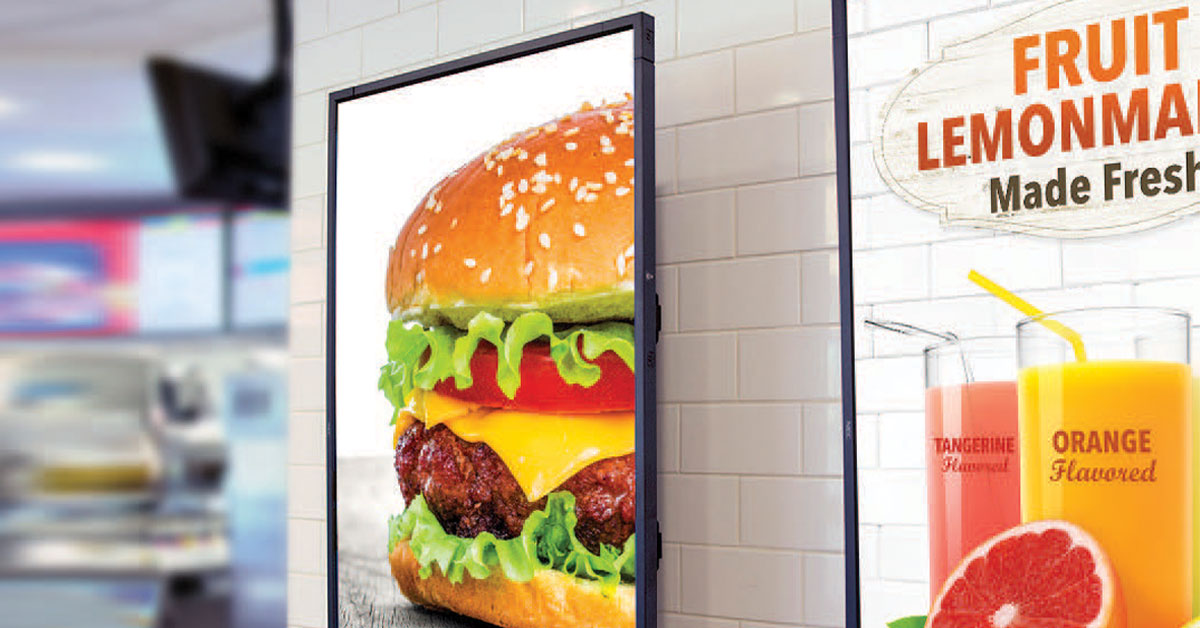Deploying high-tech displays entails research and strategizing
Static menu boards are on the decline as foodservice operators upgrade to digital signage solutions. Operators are looking to these state-of-the-art digital displays that boast visually appealing aesthetics, not to mention easy-to-update menu items, to help them compete in a crowded foodservice environment.
In general, a digital signage system makes it easier for the operator to:
- Update prices
- Showcase new menu items
- Remove a selection when that product is sold out.
More robust systems can help operators:
- Boost sales
- Improve customer service
- Increase brand loyalty
There is more to a digital signage solution than bold graphics. Operators must consider several factors when shopping for digital signage systems or networks. These details range from practical issues such as reliability and ease of use to big-picture features such as how the system can help the operator achieve long-term sales and operational goals.
Here are four key factors that can help an operator successfully deploy a digital signage system. Moving from static to digital signage
Deploying high-tech displays entails research and strategizing
1. Set goals
First, an operator should examine what he hopes to accomplish with the new system, other than
displaying content in a more animated way.
“Make sure you have all the clearly defined goals — your technology strategy if you will,” says Jason Shelton, national account manager, vertical sales-QSR/retail for NEC Display Solutions of
America, Inc. “Make sure you define your short-term goals and long-term goals. A system should last
three to five years or, in our case, seven to 10 years.”
A short-term goal might be to reach a specific sales goal for a limited time offer (LTO). For this, the operator would use a system that displays the new content and then reports whether the messaging helped to boost sales of the menu item. A longer term goal would be for a quick-service operation to decrease total order times, an operational process that involves getting the right messaging on the displays so that consumers know what they want to order before they reach the counter. NEC is a leading provider of commercial LCD displays and projectors, and offers a portfolio of solutions for retail, education, health care and other facilities. Foodservice operators use the displays to:
- Keep traffic flowing
- Engage with customers
- Control energy costs
2. Prevent dark screens
In the food service industry reliability is the most important factor. If the screens go dark the business can come to a standstill. The operator can probably hand out paper menus, but that slows the process and the low-tech approach can reflect poorly on the brand.
“You want to make sure the display products you’re choosing has a fail rate that is significantly low,” Shelton says. “You don’t want to invest in consumer-grade products because they aren’t designed or warranted to support the run rate and daily use.”
Shelton explains that commercial grade solutions have ratings. Monitors can be rated for use for 16 hours a day, seven days a week, which he says is adequate for most operators. There are also monitors rated for 24/7 unlimited usage, which many foodservice operators are looking for these days.
When looking for monitors, the operator should consider such details as:
- Anti-glare screens
- High-resolution displays
- Whether the equipment is in a robust mechanical structure
The monitor is not the only part of the digital signage system — there are also media players, software and network. “If you have one weak link the entire system is compromised,” Shelton says. In addition to choosing the right product based on the expected usage, the operator should look for a provider that offers a warranty and support. “Do you have the resources as an organization to service and maintain the screens, or are you looking at manufacturers like NEC to do that,” Shelton says. “What are the expectations and do you get next day service.”
3. Eliminate operator error
User interface is another key piece, Shelton says. It should be easy to change the messaging for new menu items or seasonal offers. NEC monitors are compatible with many different types of systems, so that the user can change menu items by plugging a media player into the back of the monitor or via the cloud. Other details such as electrical infrastructure, cabling and network requirements are also important.
4. Price
Price also is a factor, but the good news is the affordability of digital systems has improved lately. “One reason we’re seeing a shift to digital is our solutions are comfortably priced, even compared to a static solution,” Shelton says. “It’s important for operators to look not only at digital displays but also at what it is they are trying to achieve as it compares to static displays.”
NEC Display Solutions of America, Inc., a leading designer and provider of innovative displays, offers the widest range of products on the market, such as commercial- and professional-grade large-screen LCD displays, desktop LCD monitors, direct view LED displays, a diverse line of multimedia and digital cinema projectors, and integrated display solutions. Benefitting from the technologies of NEC Corporation and its own Research and Development, NEC produces leading-edge visual technology and customer-focused solutions for a wide variety of markets, including education, retail, transportation, broadcast, enterprise, healthcare, houses of worship, and many more. NEC is orchestrating a brighter world with the quality and reliability of its products and outstanding customer service.
For additional information about NEC Display Solutions of America products, call (866) NEC-MORE, or visit the website at www.necdisplay.com. Follow us on our social media channels: Facebook, YouTube, Google+, Twitter and LinkedIn

